Coeur d'Alene, Idaho 作者: 来源: 发布时间:2021-11-03
I.Population and Area
₋Area
Land: 16.06 sq mi (41.58 km2)
₋Population
Total: 44,137
Density: 3,264.45/sq mi (1,260.41/km2)
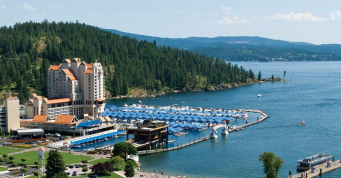
II.Natural Geography
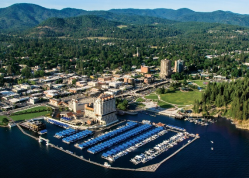
Port View
₋Coeur d'Alene (/ˌkɔːr dəˈleɪn, ˌkɜːr dəˈleɪn/ KOR də-LAYN, KUR də-LAYN, French: Cœur d'Alène, lit. 'Heart of an Awl', pronounced [kœʁ dalɛn]) is the largest city and county seat of Kootenai County, Idaho, United States. It is the principal city of the Coeur d'Alene Metropolitan Statistical Area. In 2019, the United States Census Bureau estimated the city's population at 52,414. The city is a satellite city of Spokane, which is located about 30 miles (48 km) to the west, in the state of Washington. The two cities are the key components of the Spokane–Coeur d'Alene combined statistical area, of which Coeur d'Alene is the third-largest city (after Spokane and its largest suburb, Spokane Valley). Coeur d'Alene is the largest city in North Idaho. The city is situated on the north shore of Lake Coeur d'Alene, 25 miles (40 km) in length. Locally, Coeur d'Alene is known as the "Lake City", or simply called by its initials: "CDA".
₋The city of Coeur d'Alene has grown significantly in recent years, in part because of a substantial increase in tourism, encouraged by several resorts in the area. The Coeur d'Alene Resort and a 165-acre natural area called Tubbs Hill, Coeur d'Alene, Idaho take up a prominent portion of the city's downtown. There are several ski areas nearby: Silver Mountain Resort to the east in Kellogg, Lookout Pass Ski and Recreation Area also to the east on Lookout Pass at the Montana border, and Schweitzer Mountain Ski Resort to the north in Sandpoint. The largest theme and water park in the Northwest, Silverwood Theme Park, is located approximately 20 miles to the north.
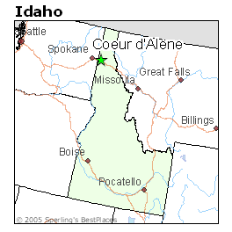
₋The city is named after the Coeur d'Alene People, a federally recognized tribe of Native Americans who lived along the rivers and lakes of the region, in a territory of 5,500 square miles (14,000 km2) extending into Washington and Montana. They were first encountered by French fur traders in the late 18th and early 19th century, who referred to them as Cœur d'Alêne, meaning "heart of an awl", reflecting their experience of the tribal traders as tough businessmen, "sharp-hearted" or "shrewd".
III.ECONOMY
₋The average salary in Coeur d'Alene, ID is $17.01. Trends in wages decreased by -100.0 percent in Q1 2020. The cost of living in Coeur d'Alene, ID is 100 percent higher than the national average. The most popular occupations in Coeur d'Alene, ID are Certified Nurse Assistant (CNA), Registered Nurse (RN), and Office Manager which pay between $11.17 and $30.61 per year. The most popular employers in Coeur d'Alene, ID are Kootenai Medical Center, North Idaho Eye Institute, and Coeur d' Alene Resort.
₋Website: https://www.payscale.com/research/US/Location=Coeur-d-Alene-ID/Salary
IV.Industrial Characteristics
₋The city is the healthcare, educational, media, manufacturing, retail and recreation center for North Idaho. Several mining firms are headquartered in the city, among them Hecla Mining (NYSE: HL). The Coeur d'Alene Resort is also a major employer.
₋Commercial
₋Coeur d'Alene's retail has expanded greatly in recent years with the opening of new stores and entertainment venues. Coeur d'Alene's Riverstone development houses a 14-theater Regal Cinemas, condominiums, a Hampton Inn, a park, restaurants, and local retailers. The North Idaho Centennial Trail bike path cuts through the Riverstone complex alongside an abandoned railroad right of way. The Citylink transit system adjoins the northwest entrance of the Riverstone complex.
₋Giant statues of bird feathers line Northwest Boulevard, celebrating the rich heritage associated with the Coeur d'Alene Tribe. Art galleries and cafes are along Sherman Avenue, Coeur d'Alene's main street. During summer, artists and musicians frequent Sherman Square.
₋In 2009, Coeur d'Alene ranked No. 12 on Newsmax magazine's list of the "Top 25 Most Uniquely American Cities and Towns," a piece written by current CBS News travel editor Peter Greenberg. In determining his ranking, Greenberg commended the city for "embracing its natural beauty and creating a small-business-friendly environment that has helped develop its thriving tourism industry."
V.Attractions
1.Tubbs Hill
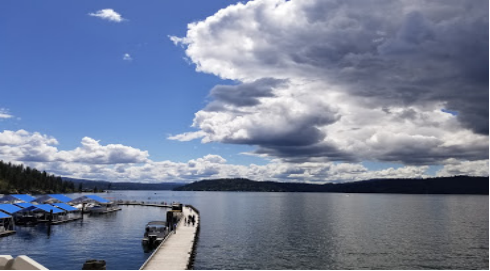
₋Tubbs Hill is a 3.9 kilometer heavily trafficked loop trail located near Coeur d'Alene, Idaho that features a lake and is good for all skill levels. The trail offers a number of activity options and is best used from May until October. Dogs are also able to use this trail.
₋Address: 208 S 3rd St, Coeur d'Alene, ID 83814, United States
₋Phone: +1 208-769-2300
₋Website: https://www.alltrails.com/trail/us/idaho/tubbs-hill?u=m
2.McEuen Park
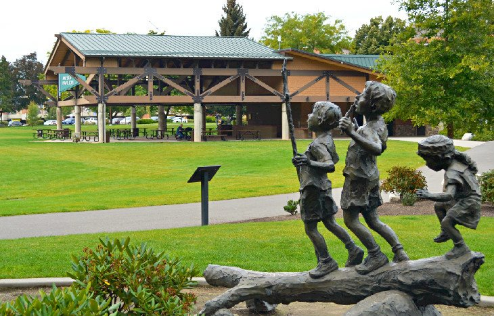
₋This park boasts the city’s largest playground, a colorful splash pad, tennis/pickle ball court, basketball court, off-leash dog park, Avista Pavilion (to host events for up to 300 people), the Rotary Harbor House (that is a waterfront concession stand/restroom facility), the sea wall overlook, grand plaza, Veterans Memorial, and 4-acre grassy area with room to hold events for up to 5,000 people. This park also hosts a boat launch, mooring facilities and a trail head for Tubbs Hill. The 60 mile Centennial Trail that begins at Nine Mile Falls, Washington and ends at Higgins Point on Coeur d'Alene Lake runs right through the middle of McEuen Park.
₋A centerpiece public space for the city, McEuen Park is the perfect place for the entire family to spend the day. Home to the city's largest playground, McEuen Park also features basketball courts, impressive pavilions, and a leash-free dog park.
₋Public art lines the bike trails and pedestrian paths that cross through the abundant green space of the park, and a beautiful grand plaza area with landscaped waterfalls, garden beds, and a Veterans Memorial facilitates peaceful time during the day.
₋The trailhead for Tubbs Hill can be found at the southwest corner of the park next to the water, and the adjacent Harbor House provides summer-fun concessions and seating with a view.
₋Website: https://www.cdaid.org/751/departments/parks/all-parks/mceuen-park
3.Coeur d'Alene City Park
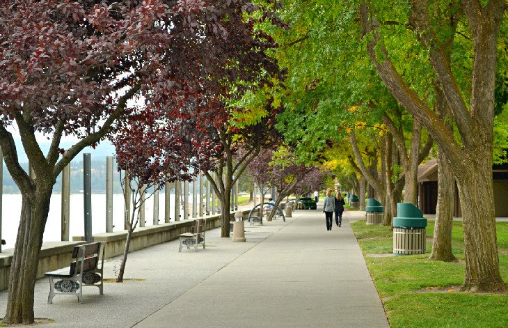
₋On the waterfront west of downtown, Coeur d'Alene City Park features 16 acres of beach and landscaped green space complete with an inviting playground. An easy way to connect with the surrounding scenic environment, a cement promenade separating the beach and green space is lined with trees and is great for afternoon strolls. From the beach area, passing boats on the lake add to the attractive backdrop, as do the seaplanes that touch down on the water.
₋The historically-themed and recently renovated Fort Sherman Playground is a big hit within the city park for young children and parents alike. A center for community attractions and events, Coeur d'Alene City Park holds a variety of engagements throughout the year, including movies in the park and live music in the bandshell. Nearly connected to the park a block away, the historic Fort Sherman Chapel is the oldest church in Coeur d'Alene and is accessed with a short and scenic walk through a charming neighborhood.
₋Website: https://www.cdaid.org/735/departments/parks/all-parks/coeur-dalene-city-park
VI.History
₋The Coeur d'Alene people called themselves by the autonym Schitsu'umsh in Coeur d'Alene, one of the Salishan languages, meaning "The Discovered People" or "Those Who Are Found Here."
₋This area was extensively explored by David Thompson of the North West Company starting in 1807. The Oregon boundary dispute (or Oregon question) arose as a result of competing British and American claims to the Pacific Northwest of North America in the first half of the 19th century. The British had trading ties extending from Canada and had started settlements in present-day British Columbia and at Fort Astoria on the Pacific coast near the mouth of the Columbia River.
₋The Oregon Treaty of 1846 ended the disputed joint occupation of the area in present-day Idaho when Britain ceded all rights to land south of the 49th parallel to the United States. When General William T. Sherman ordered a fort constructed on the lake in the 1870s, he gave it the name Fort Coeur d'Alene; hence the name of the city that grew around it. The name of the fort was later changed to Fort Sherman to honor the general. North Idaho College, a community college, now occupies the former fort site. The lake was also named for the Coeur d'Alene.
₋Miners and settlers came to the region after silver deposits were found. It became the second-largest silver mining district in the country, generating both great wealth and extensive environmental contamination and damages. In the 1890s, two significant miners' uprisings took place in the Coeur d'Alene Mining District, where the workers struggled with high risk and low pay. In 1892, the union's discovery of a labor spy in their midst, in the person of Charlie Siringo, sometime cowboy and Pinkerton agent, resulted in a strike that developed into a shooting war between miners and the company.
₋Years later Harry Orchard, who owned a share of the Hercules Mine in the nearby mountains before it began producing, confessed to a secret, brutal and little understood role in the Colorado Labor Wars. He later confessed to dynamiting a $250,000 mill belonging to the Bunker Hill Mining Company near Wardner during another miners' uprising in 1899. He later returned to Idaho to assassinate former Idaho Governor Frank Steunenberg in 1905.
₋Due to the scenic lake, tourism increased with the completion of highway infrastructure projects in the 1950s and 60s and the Coeur d’alene Chamber of Commerce began to promote the city as a tourist destination as well. As tourism increased, lodging facilities and demand for other amenities catering to them such as motels, convention space, restaurants, and cultural activities began to increase. By 1976, the city had over 30 motels with about 1,500 rooms. On June 14, 1958 the city hosted the first Diamond Cup Hydroplane race which was one of the largest events in it’s history and the event garnered national publicity and media coverage. The event attendance was 30,000 people and was considered a success by the Diamond Cup organizers and the race was held at Lake Coeur d’alene for the next eight years until it was eventually discontinued due to persistent difficulties in raising funds for the event.
₋Tourism has taken on even more prominence and became one of the main drivers of the local economy since the start of the 1980s, which saw new investment into recreational tourism in the area. In 1982, the city saw the opening of a $2 million Wild Waters aquatic theme park, and spring 1986 saw the opening of the $60 million and 18 story Coeur d’alene Resort. The waterfront resort featured a well manicured frontage and a publicly accessible floating boardwalk gave visitors the impression of a park-like environment and made Coeur d’alene a major tourist destination in the eyes of many as it attracted the attention of publications nationwide.
₋In 1986 Coeur d'Alene was presented the Raoul Wallenberg Award for its stand against neo-Nazis.
VII.Other Information
₋Roads and highways
₋Coeur d'Alene is accessed from Interstate 90 at Exits 11 through 15. The greater Coeur d'Alene area is almost entirely dependent upon private automobiles for transportation. Combined with the city's rapid growth since 1990, relative congestion now occurs on a significant portion of the area highways, notably U.S. 95 between Northwest Blvd. north to Hayden. Before the construction of I-90, the city was served by U.S. Route 10, which ran through downtown. This route is Northwest Boulevard and Sherman Avenue. The former US 10, between I-90 exits 11 and 15, is now designated as Interstate 90 Business.
₋Public transportation
₋Free public bus service is available to area residents, provided by Citylink. Citylink buses operate in the urbanized area of Kootenai County, leaving the Riverstone Transfer Station every sixty minutes, seven days a week, including holidays. Buses are wheelchair-accessible and can transport up to two bicycles.
₋The bus system comprises four separate routes:
žUrban Route B – Serves Post Falls, Hayden and West Coeur d'Alene.
žUrban Route C – Serves Downtown Coeur d'Alene, Fernan and Hayden.
žRural Route – Serves the towns of Worley, Plummer, Tensed and DeSmet.
žLink Route – Connects the two transfer stations at Riverstone and Worley.
₋As of April 2012, major changes were made to the current routes, including the elimination of the "Urban Route A", which went out to Stateline, 125 new stops added to the system, the "Urban Route B" and the "Urban Route C" changing to two-way service instead of loop service, and the routes leaving from Riverstone more frequently, from every eighty-five minutes down to sixty. Changes were made primarily due to budget cuts.
₋Airports
₋The closest major airport serving Coeur d'Alene and North Idaho is Spokane International Airport, which is served by six airlines and is 40 miles (64 km) to the west in Spokane, Washington. Coeur d'Alene Airport – Pappy Boyington Field (KCOE) is a general aviation airport in Hayden, north of the city near U.S. 95.
₋The local Coeur d'Alene Airport is a public-use, general aviation airport. In 1941, the Coeur d’Alene Chamber of Commerce promoted the purchase of 720 acres (290 ha) of land on the Rathdrum Prairie for the Coeur d’Alene Airport. The facility was built in 1942 by the Army Engineers at a cost of over $400,000. It was designated as an alternate to Weeks Field (now, Kootenai County Fairgrounds) when a war training program was in operation for World War II.
₋Utilities
₋The city of Coeur d'Alene provides for municipal water, sewer and stormwater management, street lighting, garbage collection, and recycling.
₋Healthcare
₋Kootenai Health is the primary medical center serving the Coeur d'Alene and north Idaho area. With over 3,400 employees, it is the largest employer in Kootenai County.
VIII.Contact Information
Government
Mayor: Steven Widmyer
City Hall
Office Location:
710 East Mullan Avenue
Coeur d'Alene, Idaho 83814
Telephone:
Parks & Cemetery Information - (208) 769-2252
Urban Forestry - (208) 769-2266
Office Hours:
Monday - Friday
8 a.m. - 5 p.m.
Email: parks@cdaid.org
Website: https://www.cdaid.org/1120/departments/parks/contact-us
